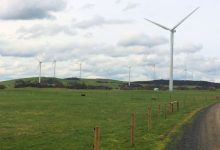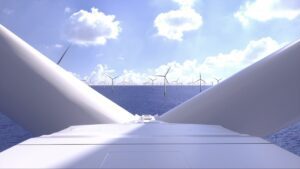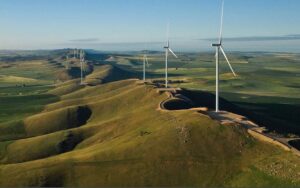The 106MW Bald Hills wind farm in Victoria’s South Gippsland region has become the subject of Australia’s first group legal action alleging a link between turbine noise and health impacts, after a claim was lodged with the state’s Supreme Court.
The complainants, a group of 12 residents from four surrounding properties owned by the Fairbrother, Jelbart, Uren and Zakula families, are seeking to have the wind farm reduced in size, or shut down, as well as compensation for health and financial impacts they say they have suffered.
The group’s statement of claim says the wind farm has devalued their properties and caused them “great discomfort, distress, inconvenience, disturbance and upset including headaches, earaches, neck aches, tinnitus, unpleasant pulsing sensations, disturbed sleep, stress and annoyance, and have rendered the affected properties unhealthy and uncomfortable to live and work in.”
The court case follows last year’s determination by the South Gippsland Shire Council that Bald Hills had caused nuisance under Victoria’s Public Health and Wellbeing Act – a decision that followed a Supreme Court of Victoria ruling requiring the Council to engage an independent health assessor to consider the complainants’ concerns.
The investigation – commissioned by the Council at a cost of $33,600 – was conducted by James C. Smith and Associates. It found that there was “a nuisance caused by wind farm noise, in that, the noise is audible frequently within individual residences and this noise is adversely impacting on the personal comfort and wellbeing of individuals.”
As reported in the legal news site Lexology, in reaching its finding, “the Council attributed weight to noise logs, and evidence of health impacts provided by the complainants”.
Lexology points out that “significantly, the decision was made notwithstanding reported compliance with the noise conditions of the planning permit for Bald Hills Wind Farm.” As The Australian reported on Tuesday, the claimants are seeking to prove Bald Hills has failed to comply with its permit.
Lexology also noted that the Council-commissioned report featured a problematic lack of “directly comparable data correlating timing, location and nature of noise emissions between the formal noise compliance monitoring and the noise complaints presented.”
The owners of Bald Hills, the Australian Renewables Income Fund, has said the wind farm would be “vigorously defending the claim,” but could not provide ongoing commentary on the matter due to it being before the court.
Bald Hills, which has been sending power to the grid since May 2015, has had a somewhat troubled existence, dating back to when it was first being developed by original owners, Mitsui.
In 2012, former Independent Senator for Victoria John Madigan – a seasoned anti-wind campaigner – called on the federal environment minister of the time, Labor’s Tony Burke, to intervene and block the project’s development, due to its threat to migratory birds.
Obviously, his wish was not granted; but the now-completed project has been under fire from a core group of locals for years, and even found its way onto A Current Affair, in a November 2018 segment titled “Not in our Backyard.”
Claims that wind turbine noise – both those sounds that are detectable to the human ear and the “infrasound” that is undetectable – can affect the health and well-being of humans and animals are nothing new. And the Murdoch media loves to report them.
In May 2012, The Australian wondered aloud whether South Australia’s Waterloo Wind Farm might be causing mutations of chicken embryos, spikes in “sheep deformities” and “reports of erratic behaviour by farm dogs.”
But as Ketan Joshi reported here, the findings of an EPA investigation into the Waterloo claims found the project’s noise levels complied with its guidelines, and that noise resulting from other environmental sources – such as the actual wind – were often louder than the turbines.
In that case, the EPA also found that residents were reporting noise issues from the wind farm during periods that the turbines were shut down.
To date, there is little credible scientific evidence to support the claim that wind turbine noise in and of itself causes people to become unwell. Rather, European studies have found that between 5 and 20 per cent of people living near wind farms can be annoyed to varying degrees by turbine noise.
The degree of annoyance tends to be much higher in people if the turbines are in their line of sight, if the complainants are not being paid for hosting turbines on their land, or if they believe the authorities have treated them unfairly. (Or, we might add, in the case of Epruon’s proposed wind farm in St Patrick’s Plains in Tasmania, if it is believed the view of the turbines will “severely diminish their angling experience” at nearby trout farms.)
National coordinator of the Australian Wind Alliance, Andrew Bray, said non-scientific evidence had been presented to courts and tribunals from time to time over recent years, but in every case, had been thrown it out.
“The Bald Hills Wind Farm is operating safely and according to its development approval. It received its final compliance notice in August 2018,” Bray told RE in an emailed statement.
“Wind farm planning standards are there to protect the health and amenity of residents. When a wind farm is compliant with planning permit conditions, as Bald Hills is, neighbours can be assured that noise emitted by the wind farm is at safe levels.
“In the most recent such case the Full Court of the Supreme Court in South Australia the court upheld the decision from the Environment, Resources and Development (ERD) Court that noise from wind farms don’t cause health effects.
“In an affidavit to the ERD Court, Professor Wittert said: ‘There is no evidence that audible noise resulting from the operation of wind turbines constitutes a significant risk to health provided the development is compliant with current guidelines.’ The court accepted ‘all of Professor Wittert’s evidence and his conclusions’,” Bray said. (You can see th full decision here.)
Certainly, this case will be one to watch.








